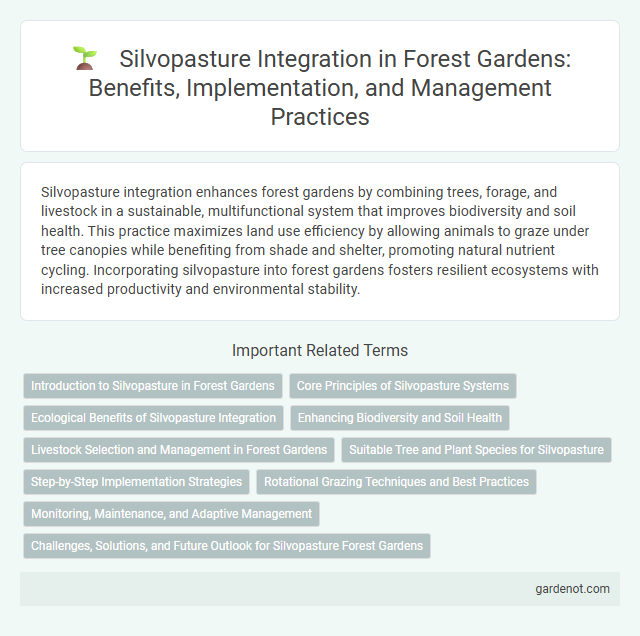Silvopasture integration enhances forest gardens by combining trees, forage, and livestock in a sustainable, multifunctional system that improves biodiversity and soil health. This practice maximizes land use efficiency by allowing animals to graze under tree canopies while benefiting from shade and shelter, promoting natural nutrient cycling. Incorporating silvopasture into forest gardens fosters resilient ecosystems with increased productivity and environmental stability.
Introduction to Silvopasture in Forest Gardens
Silvopasture integration in forest gardens combines trees, forage, and livestock management to create a sustainable and productive agroforestry system. This approach enhances biodiversity, improves soil health, and increases carbon sequestration while providing diverse income streams from timber, pasture, and animal products. Implementing silvopasture within forest gardens optimizes land use and fosters ecological balance by mimicking natural forest ecosystems.
Core Principles of Silvopasture Systems
Silvopasture systems integrate trees, forage, and livestock to create multifunctional landscapes that enhance biodiversity and productivity. Core principles include maintaining tree canopy for shade and shelter, managing understory forage for optimal livestock nutrition, and implementing rotational grazing to prevent soil degradation. These principles optimize resource use, improve animal welfare, and promote sustainable land management in forest garden ecosystems.
Ecological Benefits of Silvopasture Integration
Silvopasture integration enhances biodiversity by combining trees, pasture, and livestock, creating diverse habitats that support a wide range of species. This system improves soil health through increased organic matter and nutrient cycling, reducing erosion and enhancing water retention. Additionally, silvopasture promotes carbon sequestration by combining forestry and grazing, contributing to climate change mitigation.
Enhancing Biodiversity and Soil Health
Silvopasture integration in forest gardens promotes diverse plant species and animal habitats, significantly enhancing biodiversity. The combination of trees, forage, and livestock improves soil structure, nutrient cycling, and organic matter content, leading to healthier, more resilient soils. This symbiotic management system supports ecosystem services such as carbon sequestration and pest control, fostering sustainable agricultural productivity.
Livestock Selection and Management in Forest Gardens
Livestock selection in silvopasture within forest gardens prioritizes species like goats, sheep, and poultry that adapt well to shaded, multi-layered environments. Effective management includes rotational grazing to prevent overbrowsing and soil compaction, maintaining tree health while optimizing forage availability. Integrating livestock contributes to nutrient cycling and pest control, enhancing overall forest garden productivity and sustainability.
Suitable Tree and Plant Species for Silvopasture
Ideal tree species for silvopasture integration include nitrogen-fixing trees such as black locust (Robinia pseudoacacia) and honey locust (Gleditsia triacanthos), which enhance soil fertility and provide shade. Understory plants like forage legumes (Trifolium spp.) and shade-tolerant grasses optimize animal grazing and nutrient cycling. Combining deep-rooted trees like oak (Quercus spp.) with diverse, palatable forage species maximizes productivity and biodiversity in forest garden silvopasture systems.
Step-by-Step Implementation Strategies
Silvopasture integration requires careful planning to combine trees, forage, and livestock in a synergistic forest garden system. Begin by selecting compatible tree species that provide shade and fodder, followed by establishing rotational grazing zones to prevent overgrazing and promote soil health. Implement fencing and water infrastructure strategically to support livestock movement and protect young trees during the initial establishment phase.
Rotational Grazing Techniques and Best Practices
Silvopasture integration enhances forest garden productivity by combining trees, forage, and livestock through rotational grazing techniques that optimize land use and animal health. Implementing best practices such as controlled grazing periods, adequate rest intervals, and strategic paddock design promotes soil regeneration, reduces overgrazing, and improves biodiversity. These methods increase forage quality and timber yields while maintaining ecosystem resilience and sustainable pasture management.
Monitoring, Maintenance, and Adaptive Management
Silvopasture integration in forest gardens requires continuous monitoring of tree health, pasture quality, and livestock behavior to optimize productivity and ecosystem balance. Maintenance activities include controlled grazing, pruning, and soil management to enhance nutrient cycling and prevent overgrazing. Adaptive management strategies involve adjusting stocking rates, species composition, and spatial arrangement based on real-time data and environmental feedback to sustain resilience and biodiversity.
Challenges, Solutions, and Future Outlook for Silvopasture Forest Gardens
Silvopasture integration in forest gardens faces challenges such as balancing tree density with livestock forage needs and managing soil compaction from grazing animals. Solutions include selecting compatible tree and pasture species, implementing rotational grazing systems, and using fencing to protect young trees. Future outlook emphasizes improved multispecies management techniques, precision monitoring technologies, and policies supporting sustainable silvopasture practices to enhance productivity and ecosystem services.
Silvopasture integration Infographic

 gardenot.com
gardenot.com